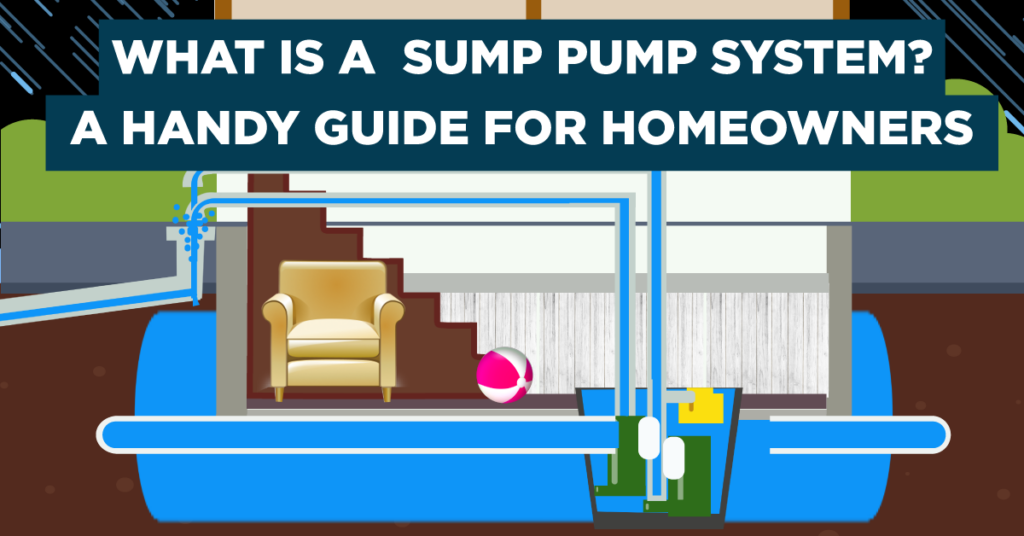
The Midwest and East Coast are known for their hot summers and cool winters. High water tables in these areas often lead to an intense and damaging problem many homeowners face: basement flooding.
A recent report shows that almost all basements (98%) experience water damage. As stated by the Environmental Protection Agency (EPA), flooding is increasingly concerning along the United States coastline, particularly impacting the East Coast.
Living in a flood-prone area emphasizes the significance of safeguarding your home against water damage. By investing in a reliable sump pump system, you may be able to properly protect your property.
If you want to reduce stress during harsh weather conditions, consider getting a basement sump pump kit. This article is here to provide you with useful information to help you choose the right system for your home’s needs. But first, it helps to learn what a sump pump system is.

Sump pumps remove accumulated water beneath your property, which can happen due to heavy rainfall or drainage system failure. But how does a sump pump system work? It functions by drawing in water from a drain tile under your foundation, pumping it through a discharge pipe, and pushing it away from your property.
Not all sump pump types are similar; each has advantages and limitations. Below are a few sump pump types you’ll likely encounter.
Submersible sump pumps have their motor and pump submerged in a basin. They use a float mechanism to activate it once the water levels rise high enough above the motor.
These are popular among homeowners since they’re much quieter than other sump pump types and are designed to be in the water. Prolonged dry periods may begin to dry out gaskets and dry rot the sump pump over time. It’s important to exercise your sump pump every day to lubricate the components.
The motor of a pedestal sump pump sits on a shaft above a basin, allowing it to remain high above the ground. A float system hangs beside it.
The float system rises once water levels are high enough, triggering the sump pump system to expel the accumulated water. These systems are ideal for basements that collect lower water levels. However, since they sit above the water, they can overheat easier and tend to be noisy.
These sump pumps feature a primary and backup system that automatically activates in a power outage. Many homeowners find them to be the most cost-effective solution. However, these systems are often bulky because they include multiple pumps, making them best for larger sump pits or wells.
Battery backup sump pumps are perfect if you live somewhere that frequently experiences intense weather conditions that disrupt your home’s electricity. These systems operate on batteries, allowing you to manage your flooded basement even when your power is out.
Flooded basements threaten your health, safety, and your home’s structural integrity. Here are some of the benefits it can provide you.
Water can cause wood to soften or rot, affecting your home’s structural integrity. Metal pipes can also suffer from water damage in the form of rust, which can alter your home’s water quality.
Sump pumps can help eliminate water in your basement, protecting you from these circumstances and more.
Water in your basement can lead to several potential health risks for you and your family.
During a storm, water infiltration into your home’s electrical wiring systems can pose a risk of electric shocks to you or your family if they come into contact with it in your basement. Additionally, there’s the concern that pets could drink toxic groundwater in your basement, which can contain countless harmful bacteria.
A long-term effect of basement water damage that many homeowners miss is molding. These usually grow in damp areas and can release allergy-triggering spores in the air.
Since a sump pump provides several benefits to homeowners, having it will make your property more attractive to homebuyers if you eventually decide to sell it. It can also save you thousands in water damage repair, which makes it an excellent long-term investment.
To safeguard electrical appliances in your basement, such as washing machines and heating systems, you must prevent them from submerging in water.
Once water enters these appliances, there’s a risk of short circuits and sparks, potentially igniting nearby dry materials. A sump pump can avoid these unfortunate incidents since it helps prevent water from rising to a level that would damage your appliances.
Your basement may store valuable items that aren’t used daily. If your basement doesn’t have adequate protection, groundwater or rainfall can seep into it, damaging your belongings. Fortunately, a basement sump pump kit can minimize and mitigate these risks, keeping your valuables dry and undamaged. Some systems include a humidity and temperature sensor that can notify you of a drastic change.
As powerful as a basement sump pump kit, its effectiveness depends on how you manage and maintain it.
While being an expert isn’t necessary to use a sump pump, avoiding common mistakes goes a long way in helping you maximize its capabilities. Below are a few mistakes that most homeowners make that limit the sump pump’s ability to perform well.
You should install a pump that’s the right horsepower and size for your space to ensure effective water removal from your basement. Some sump pumps are designed to fit into tight crawl spaces, while others require a larger sump pit basin to work properly. To avoid this mistake, measure the available space and consider how high water levels can rise during a storm.
Power outages and disruptions are common during storms, precisely when you rely on your sump pump the most. Since most sump pump motors run on electricity, you must have a backup power source, whether a solid generator or battery system, to ensure it continues operating even during power failure.
Like any other device, you must maintain sump pumps to ensure they last for years. Regular maintenance will depend on the type of sump pump type you have. Water seepage can cause severe damage to pedestal sump pumps, while submersible pumps are designed to handle such situations and are less prone to damage.
Always ensure that your sump pump’s wiring, motor, values, basin, and switches are intact to help extend the device’s lifespan.
Testing your sump pump allows you to check for any potential damage in the system.
To test your sump pump, pour water into its basin at the rate you think rainwater may enter during a storm. Keep pouring until the system activates. Once the motor runs, monitor how fast water drains from the basin and listen for any odd sounds emitted by the sump pump. If the water level doesn’t drop or it makes a strange noise while it operates, it may be time for a repair.
Debris, such as leaves, dirt, and plastic, can clog your sump pump’s discharge pipes, limiting how much water it can eliminate from your basement. It’s a good practice to test them, especially before a big storm, to ensure it’s still effective in pumping water out of your home.
When you aren’t sure why your sump pump isn’t working, don’t hesitate to contact a professional service provider like Basement DefenderTM.
Troubleshooting sump pump issues can be tedious, and attempting repairs without proper knowledge can potentially worsen the damage. Professionals have the expertise to address your sump pump concerns and may even improve its performance.
Since there are many different sump pump types, it’s best to be careful with which you choose for your home. Below are tips to ensure you get the right basement sump pump kit for your home.
You should take your location into account when choosing a sump pump system. The weather events and rainfall in your area determine the water volume your sump pump needs to handle. Your home’s discharge line height (head) length, and diameter will help narrow your options.
Additionally, you should consider your underground water table, which is the water directly under your home’s foundation. If you live on a high water table like near a lake or river, your sump pump might run nonstop regardless of the weather. Water can enter your basement from small cracks, which could require a stronger sump pump to clear out.
How much are you willing to spend to protect your home and belongings? Sump pump system costs will vary depending on what type you get, its size, and even accessories.
As a reference, Basement DefenderTM’s Battery Backup Kit costs $245, pumps 31.31 gallons per minute, and has a three-year warranty. The prices can vary depending on the specific features you need and the system size you require.
A reliable service partner will provide hands-on guidance when deciding which system and accessories you need for your unique concerns.
You must not only consider the equipment itself but also pay attention to certifications and the reputation of the company behind it. For example, Basement DefenderTM, created by Roy Spencer with over 40 years of waterproofing experience, is a credible source for protecting your basement or crawl space.
Buying just the right sump pump prevents you from overspending on an overpowered motor. For houses with a higher-than-average water table, it is recommended to use a 1/2 horsepower sump pump, while homes with deep basements or very high water tables are best suited with a 3/4 horsepower sump pump.
Higher-tech, smart sump pumps include built-in alarms and Wi-Fi connectivity, with daily testing and alert services that allow you to protect your home better.
As an example, Basement DefenderTM’s Sump Pump Monitoring System incorporates a temperature and humidity sensor that detects leaks and flooding in your basement if the humidity level suddenly rises. The temperature sensor lets you know if the temperature drops in your basement so you can prevent your pipes from freezing and bursting. The Basement DefenderTM App lets you monitor your sump pump’s performance and access real-time drainage data.
Many homeowners would agree that sump pumps are essential, especially in areas where storms often pass through. They’re reliable devices that protect your home from flooding and your family from health risks associated with structural water damage.
To make the most out of sump pumps, you must follow best practices such as regularly maintaining them, understanding what you need, and speaking to a professional. Adding a sump pump monitor with daily testing using Wi-Fi connectivity can also improve basement maintenance.
Basement DefenderTM tests your sump pump system every day and offers a hassle-free sump pump monitoring system that allows you to track it through your smartphone. We also sell other basement sump pump kits and accessories to enable you to customize your sump pump system according to your unique needs.

Roy is a respected authority in the waterproofing industry, with over 40 years of experience under his belt. His company, Perma-Seal, has earned a reputation as Chicagoland’s premier waterproofing contractor, thanks to Roy’s unwavering commitment to quality, integrity, and customer satisfaction.
His latest innovation, the Basement Defender, is a testament to his dedication to providing homeowners with the best possible protection against basement flooding, representing a major leap forward in the industry’s efforts to prevent water damage and save homeowners from costly repairs.